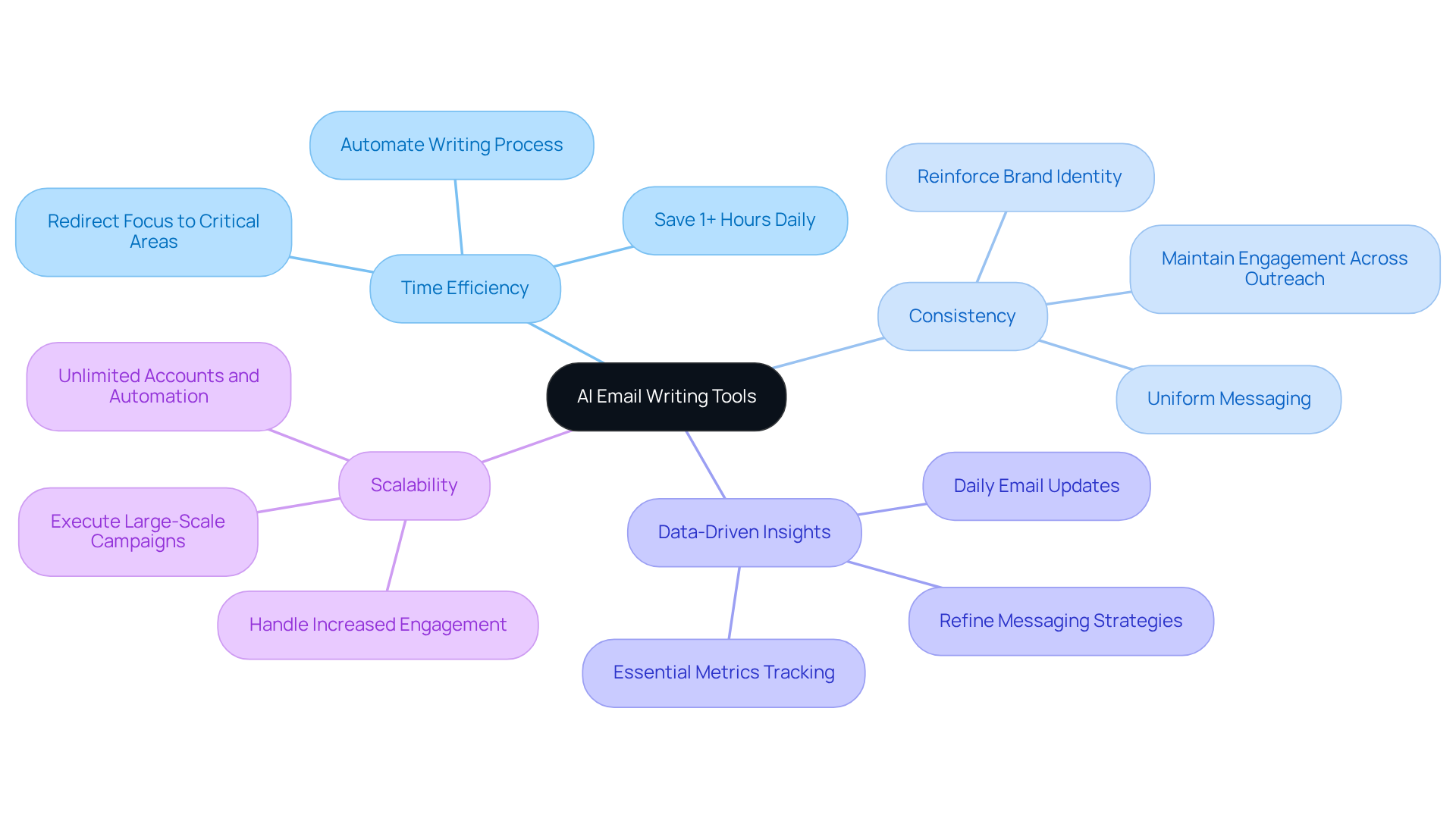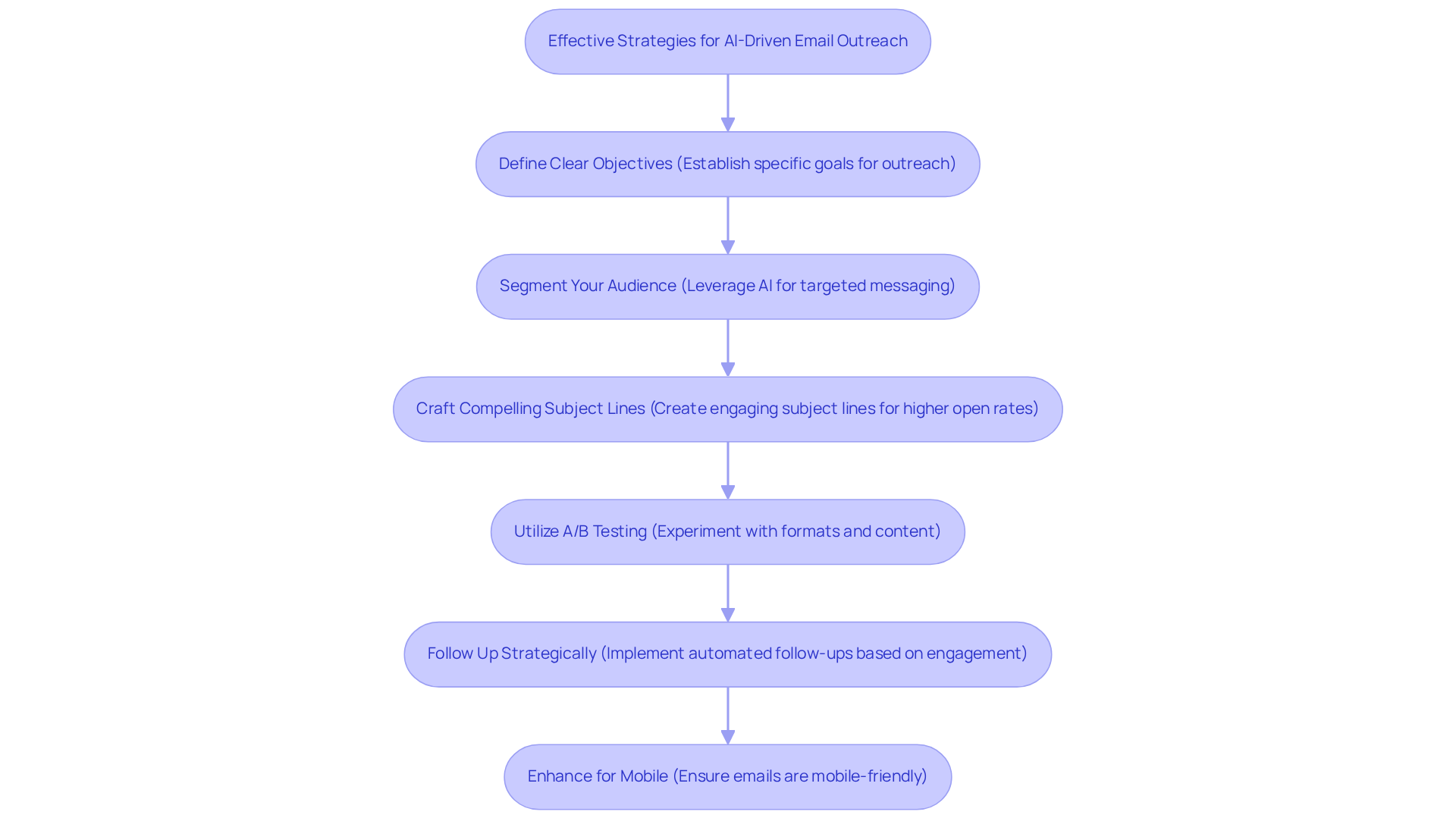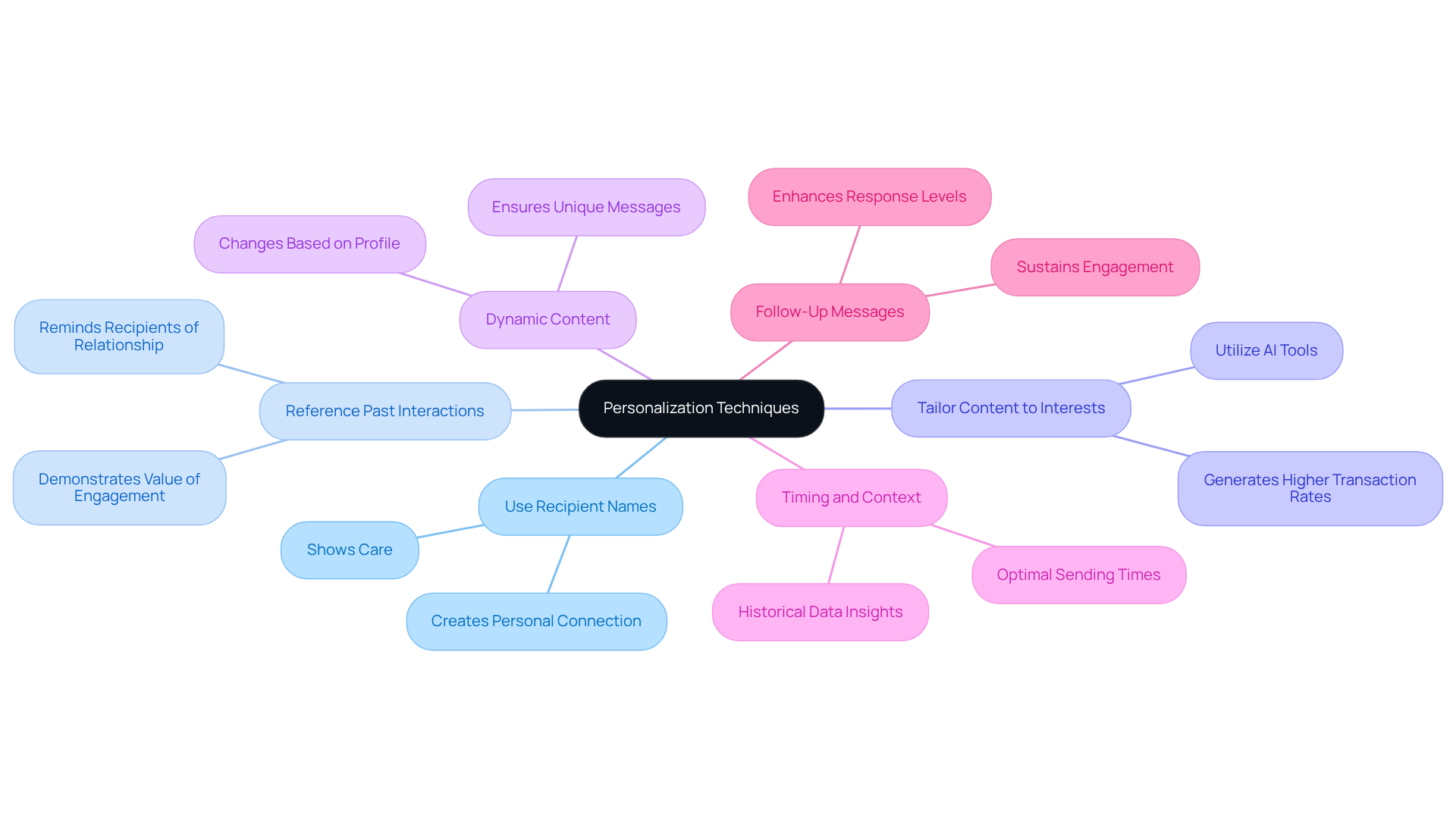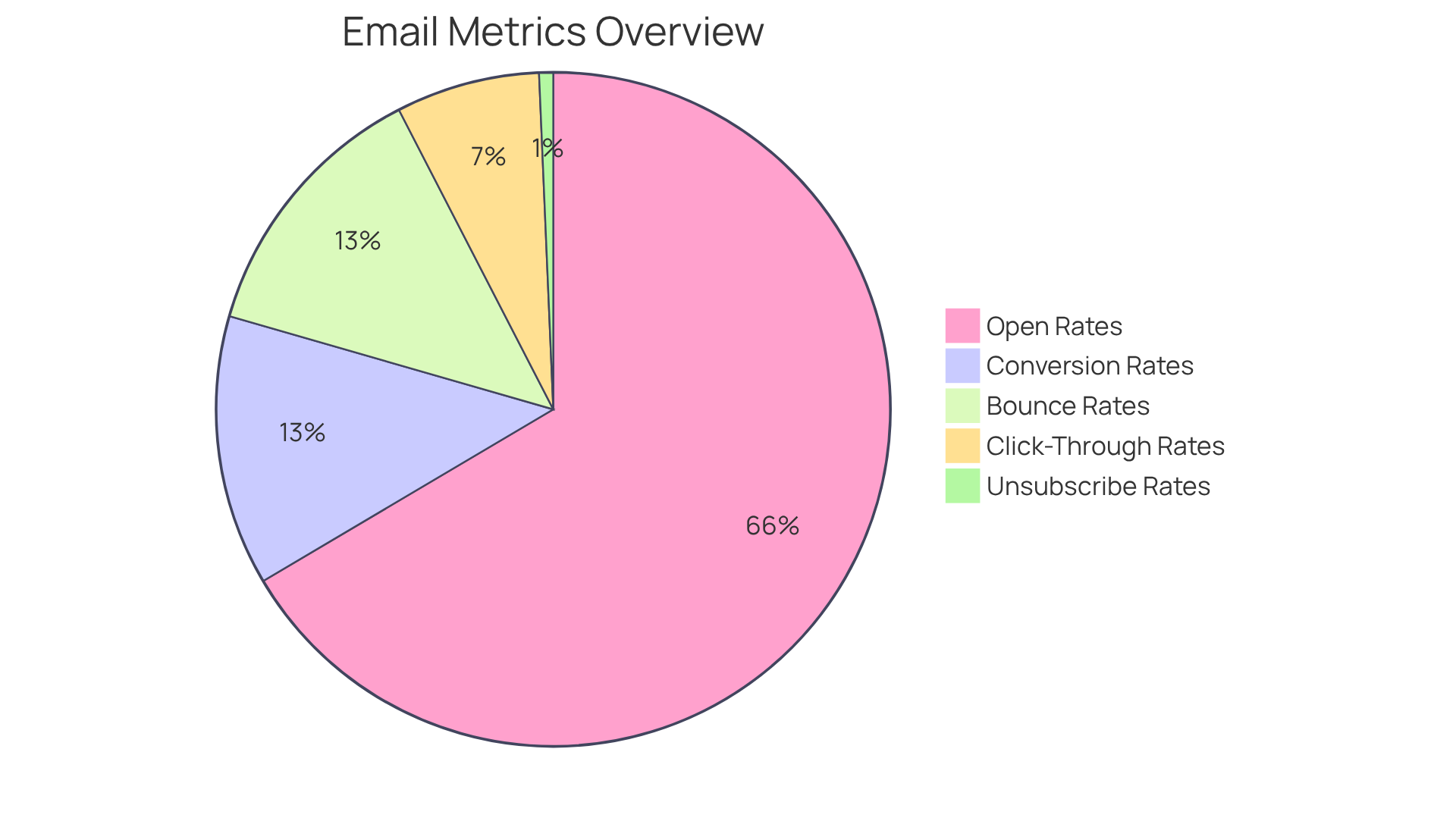Overview
This article highlights best practices for maximizing outreach through AI-driven email writing tools, particularly for small business owners who are looking to enhance their communication strategies. We understand that navigating the complexities of outreach can be challenging, which is why we emphasize the benefits of these tools in making your efforts more effective.
To truly connect with your audience, it’s essential to:
- Define clear objectives
- Segment your audience thoughtfully
Personalization techniques play a crucial role here, allowing you to tailor your messages to resonate with your recipients. Data supports these strategies, showing how they can lead to improved engagement and conversion rates, ultimately helping you achieve your business goals.
Together, we can explore these strategies to empower your outreach efforts. By implementing these practices, you not only enhance your engagement but also foster meaningful connections with your audience. Remember, your journey towards successful outreach is supported by these insights, and we are here to help guide you every step of the way.
Introduction
The landscape of email communication is experiencing a significant transformation, fueled by the rapid advancements in artificial intelligence. As small business owners like you strive to enhance your outreach efforts, AI-powered email writing tools are emerging as true game-changers, offering remarkable efficiency and customization. Yet, with an abundance of options available, how can you effectively navigate the complexities of integrating AI into your email strategies? In this article, we will explore best practices for maximizing outreach through AI email writing, providing insights that can truly transform your communication efforts and foster meaningful engagement.
Understand AI Email Writing Tools and Their Benefits
AI for email writing is truly transforming the way small business owners craft their communication messages, enabling them to do so swiftly and efficiently. By harnessing the power of sophisticated natural language processing and machine learning algorithms, these applications use AI for email writing to create customized correspondence tailored to user inputs and historical data. What are the key advantages of these solutions?
- Time Efficiency: Imagine redirecting your focus to other critical areas of your business. By automating the writing process with AI for email writing, small business owners can significantly enhance productivity.
- Consistency: Think about how essential uniform messaging is for reinforcing your brand identity. AI tools, such as AI for email writing, ensure that your communications resonate with your target audience across various outreach efforts.
- [Data-Driven Insights](https://thrivethemes.com/ai-for-small-businesses-key-stats): Platforms like Wayy.ai provide daily email updates featuring essential metrics such as the number of leads contacted, individuals who expressed interest, and conversion figures. This data-driven approach empowers you to refine your messaging strategies using AI for email writing, leading to higher engagement rates over time.
- Scalability: As your company grows, you may worry about meeting heightened engagement requirements. AI for email writing can seamlessly handle this without requiring extra resources. For instance, Mails.ai enables users to execute large-scale messaging campaigns with features like unlimited accounts and intelligent automation, ensuring effective engagement.
By grasping these advantages, you can make informed choices about incorporating AI for email writing solutions like Wayy.ai into your engagement strategies. Together, we can improve your and foster growth, ensuring that your business thrives in today’s competitive landscape.

Implement Effective Strategies for AI-Driven Email Outreach
To maximize the effectiveness of [AI-driven email outreach](https://blog.wayy.ai/10-email-samples-to-schedule-a-meeting-effectively), let’s explore some strategies that can truly make a difference for you:
- Define Clear Objectives: Begin by establishing specific goals for your email outreach. Whether it's , nurturing existing relationships, or promoting new products, having clear objectives will guide your messaging and help you measure success effectively.
- Segment Your Audience: Consider leveraging AI tools to analyze customer data and segment your audience based on demographics, interests, and behaviors. This targeted approach allows for personalized messaging, which can lead to an impressive 760% increase in revenue from segmented campaigns. Moreover, segmented campaigns yield a 38% click-through rate compared to just 4.5% for non-segmented ones, underscoring the efficiency of this strategy.
- Craft Compelling Subject Lines: Remember, the subject line is your first impression. Utilize AI for email writing to create engaging and relevant subject lines that encourage opens. Personalized subject lines can result in a 26% higher open rate, and A/B testing different subject lines can boost conversion rates by 37%.
- Utilize A/B Testing: Don’t hesitate to experiment with various formats, content, and sending times to discover what resonates best with your audience. AI tools can assist you in analyzing results, and using AI for email writing can help you refine your approach for better engagement.
- Follow Up Strategically: Implement [automated follow-up sequences](https://blog.wayy.ai/10-essential-prospecting-tools-for-small-business-owners) based on recipient engagement. This ensures you remain top-of-mind without overwhelming prospects. Triggered messages boast an average open rate of approximately 45%, significantly higher than typical campaigns. Additionally, using AI for email writing can personalize these follow-ups based on the content a prospect engaged with, enhancing their relevance.
- Enhance for Mobile: It’s essential to ensure your messages are mobile-friendly, as 50% of users discard communications that aren’t tailored for mobile devices. This is crucial for maintaining engagement and preventing the loss of potential customers.
By embracing these tactics, small business owners can enhance their communication efforts, leading to improved engagement and conversion rates while avoiding common pitfalls like overwhelming prospects with excessive messages. Together, we can achieve success in your outreach endeavors.

Leverage Personalization Techniques to Enhance Engagement
Personalization can dramatically enhance the effectiveness of outreach communications. Here are some thoughtful techniques to consider:
- Use Recipient Names: Always address recipients by their names in the email greeting. This simple act creates a more personal connection and shows that you care.
- Reference Past Interactions: If applicable, mention previous conversations or interactions. This not only reminds recipients of your relationship but also demonstrates that you value their time and engagement.
- Tailor Content to Interests: Utilize data from your AI tools, particularly ai for email writing, to customize communication content based on the recipient's preferences, behaviors, or past purchases. Personalized content generates 6x higher transaction rates, illustrating its effectiveness in outreach efforts.
- Dynamic Content: Consider implementing dynamic content blocks that change based on the recipient's profile. This ensures that each message feels unique and relevant. By utilizing dynamic fields, you can automatically include recipient-specific details in your messages for a more customized approach.
- Timing and Context: Sending emails at times when recipients are most likely to engage is crucial. Use historical data and insights from your AI tools, including ai for email writing, to determine the best timing for your outreach.
- Follow-Up Messages: Don’t underestimate the importance of follow-up messages. Sending several follow-ups can significantly enhance response levels and sustain engagement after the initial contact.
By leveraging these [personalization techniques](https://woodpecker.co/blog/how-to-personalize-outreach), small business owners can foster deeper connections with their audience, leading to higher engagement and conversion rates. Research indicates that messages with tailored subject lines are 26% more likely to be opened, underscoring the significance of personalization in effective engagement efforts. However, it is essential to balance personalization with respect for privacy, ensuring that ethical boundaries are not crossed. Together, we can achieve success in with our audience.

Monitor Performance Metrics for Continuous Improvement
To support your ongoing outreach efforts, it's essential to track key performance metrics. Understanding these metrics can empower you to enhance your strategies and achieve better results. Let's explore some critical metrics that can make a difference:
- Open Rates: This metric reflects the percentage of recipients who open your emails, offering insight into the effectiveness of your subject lines and overall engagement. While aiming for an is ideal, remember that this can vary by industry, with some sectors achieving higher or lower averages. How does your current rate compare?
- Click-Through Rates (CTR): By analyzing how many recipients clicked on links within your messages, you can assess the relevance and appeal of your content. The optimal CTR for digital marketing is approximately 2.66%, but it can range from 1% to 5% depending on the industry. Are your links enticing enough?
- Conversion Rates: Keep an eye on how many recipients performed the intended action—like signing up for a webinar or making a purchase—after receiving your message. A conversion percentage of 5% serves as a good benchmark to aim for. What actions do you want your audience to take?
- Bounce Rates: Monitoring the percentage of messages that were undeliverable is crucial for maintaining a clean contact list and enhancing deliverability. A bounce percentage between 2% and 5% is generally acceptable. Regularly updating your contact list can help lower this percentage. Have you checked your list lately?
- Unsubscribe Rates: Pay attention to how many recipients opt out of your emails; this can reveal potential issues with your content or frequency. The average unsubscribe rate across industries is about 0.26%, with a rate below 0.5% typically considered acceptable. What feedback have you received from your audience?
By regularly reviewing these metrics, you can identify trends, understand what resonates with your audience, and make data-driven adjustments to your outreach strategies. Together, we can work towards improving your results and fostering deeper connections with your audience.

Conclusion
Incorporating AI into email writing represents a pivotal shift for small business owners who are eager to enhance their outreach strategies. By leveraging these advanced tools, businesses can achieve remarkable improvements in efficiency, consistency, and scalability. This transformation ultimately changes the way they engage with their audience, creating opportunities for deeper connections.
The article outlined several key strategies for maximizing the effectiveness of AI-driven email outreach:
- Establishing clear objectives
- Segmenting audiences
- Crafting compelling subject lines
- Utilizing A/B testing
- Ensuring mobile optimization
These are all critical components that contribute to successful email campaigns. Moreover, personalization techniques—such as using recipient names and referencing past interactions—can significantly boost engagement and conversion rates. How can you incorporate these strategies into your own efforts?
As the landscape of email communication continues to evolve, embracing these best practices becomes essential for fostering meaningful connections with potential clients. By actively monitoring performance metrics and making data-driven adjustments, small business owners can refine their outreach efforts and ensure that their messaging resonates with their audience. The integration of AI not only streamlines the writing process but also empowers businesses to thrive in a competitive environment. Together, we can stay ahead of the curve in the ever-changing world of email marketing, ensuring your efforts lead to success.
Frequently Asked Questions
What are AI email writing tools?
AI email writing tools are applications that utilize sophisticated natural language processing and machine learning algorithms to help users craft customized email correspondence efficiently, based on user inputs and historical data.
What are the benefits of using AI for email writing?
The benefits include time efficiency, consistency in messaging, data-driven insights, and scalability for growing businesses.
How does AI for email writing improve time efficiency?
By automating the writing process, AI allows small business owners to redirect their focus to other critical areas, significantly enhancing productivity.
Why is consistency important in email communication?
Consistency is essential for reinforcing brand identity, and AI tools ensure that communications resonate uniformly with the target audience across various outreach efforts.
What kind of data-driven insights can AI email writing tools provide?
Tools like Wayy.ai offer daily email updates with essential metrics, such as the number of leads contacted, interest expressed, and conversion figures, allowing users to refine their messaging strategies.
How does AI for email writing support scalability?
AI tools can handle increased engagement needs as a business grows without requiring additional resources, enabling large-scale messaging campaigns efficiently.
Can you give an example of an AI email writing tool?
Mails.ai is an example that allows users to execute large-scale messaging campaigns with features like unlimited accounts and intelligent automation for effective engagement.




